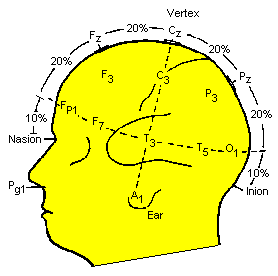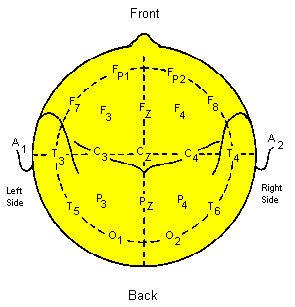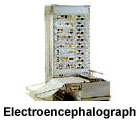Neuroscience For Kids
10-20 System of Electrode Placement |
 |
|
The 10-20 System of Electrode Placement is a method used to describe the location of scalp electrodes. These scalp electrodes are used to record the electroencephalogram (EEG) using a machine called an electroencephalograph. The EEG is a record of brain activity. This record is the result of the activity of thousands of neurons in the brain. The pattern of activity changes with the level of a person's arousal - if a person is relaxed, then the EEG has many slow waves; if a person is excited, then the EEG has many fast waves. The EEG is used to record brain activity for many purposes including sleep research and to help in the diagnosis of brain disorders, such as epilepsy. |
The 10-20 system is based on the relationship between the location of an electrode and the underlying area of cerebral cortex. Each point on this figure to the left indicates a possible electrode position. Each site has a letter (to identify the lobe) and a number or another letter to identify the hemisphere location. The letters F, T, C, P, and O stand for Frontal, Temporal, Central, Parietal and Occipital. (Note that there is no "central lobe", but this is just used for identification purposes.) Even numbers (2,4,6,8) refer to the right hemisphere and odd numbers (1,3,5,7) refer to the left hemisphere. The z refers to an electrode placed on the midline. Also note that the smaller the number, the closer the position is to the midline.
Nasion - point between the forehead and nose.
Inion - Bump at back of skull.
The "10" and "20" refer to the 10% or 20% interelectrode distance.
  |
Short Example of an EEG Signal |
Copyright © 1996-2021, Eric H. Chudler, All Rights Reserved.

